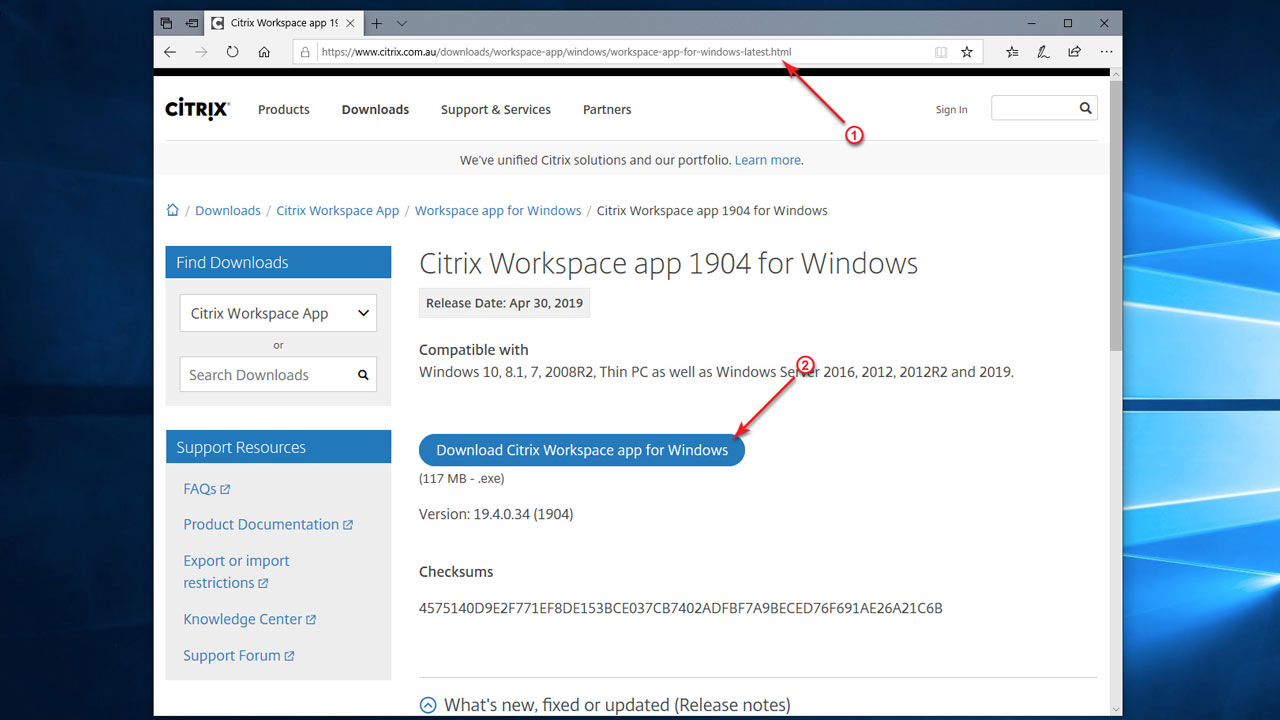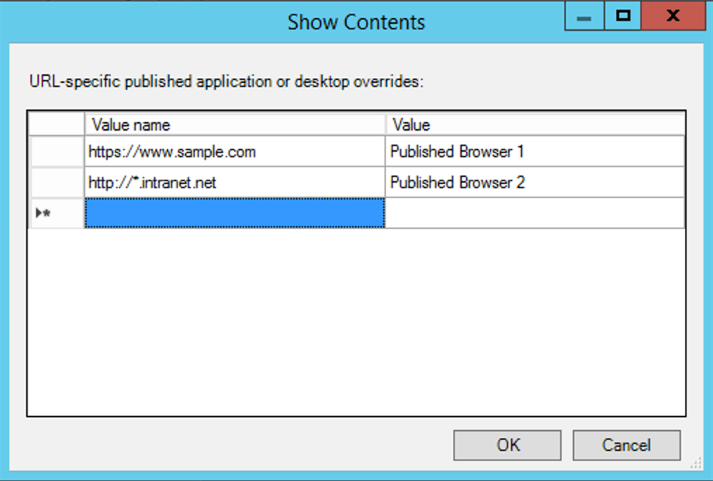- Citrix Workspace App 1907 Sccm
- Citrix Workspace App 1907 For Windows
- Citrix Workspace App 1907 Desktop Lock
Good news, after a long time coming, Microsoft Teams calling and meetings (audio, video and sharing) are now available on VDI (Virtual Desktop Infrastructure) with Citrix.
Microsoft Teams chat and collaboration has been supported in VDI for a long time, and now with the Citrix platform, calling and meeting functionality are also supported.
Audio, video and sharing are handled via WebRTC on the Citrix platform. VDA-side HDX services use an API to interface with the Microsoft Teams hosted app to receive commands. These components open a control virtual channel (CTXMTOP) to the Citrix Workspace app-side media engine. The VDI endpoint decodes and renders the multimedia locally. The video/sharing is “snapped” to the local Microsoft Teams VDI client.
Citrix have bundled all the HDX optimization code into Workspace app for Windows (versions 1907 or higher) and VDA (versions 1906.2 or higher). There will be no more plug-ins like with the Real Time Optimization Pack (RTME and RTC). Citrix have taken this opportunity to expand the feature set from RTOP.
Citrix Virtual Apps and Desktops requirements

- Citrix Files for Windows allows you to access your files directly through a mapped drive, providing a native Windows Explorer experience. Files are downloaded only when accessed, and temporarily stored on your computer. Changes made to the files are automatically saved back to the cloud.
- With this fix, Citrix Workspace app for HTML5 supports localization in the Dutch language. RFHTMCRM-2663 When you open a Citrix Workspace app for HTML5 session in a browser on a mobile device and use the display resolution dialog box to change the resolution to a fixed value that is larger than the mobile screen size, the session might not pan.
Citrix Virtual Apps and Desktops (formerly known as XenApp and XenDesktop) provide AV optimization for Teams on VDI.
You can download the latest version of Citrix Virtual Apps and Desktops here. (You’ll need to sign in first.)
The necessary components are bundled into the Citrix Workspace app (CWA) and Virtual Delivery Agent (VDA) by default. You don’t need to install any additional components or plugins on CWA or the VDA.

Recommended version – Citrix Workspace app 1911 for Windows and Minimum version – Citrix Workspace app 1907 for Windows:
Microsoft Teams Requirements
The minimum version of the Teams desktop app that’s required is version 1.2.00.31357.
Some limitations/considerations
- Windows Thin clients only, not Mac or Linux.
- Only a single incoming video stream is supported in meetings or group calls. When multiple people send video, only the dominant speaker’s video is shown at any given time.
- Update 3rd Feb 2021, 2×2 video now supported in preview details here: Microsoft Teams VDI 2×2 Gallery View Public Preview, Citrix and VMware – Tom Talks
- Only one video stream OR screen share stream is supported. When there’s an incoming screen share, that screen share is shown instead of the remote user’s video.
- Screen sharing from VDI is supported, but you must share the whole screen, sharing only specific application windows is not supported.
- Give control and take control of screen sharing is not supported. Giving remote control of a PowerPoint is supported.
- Incoming and outgoing video stream resolution is limited to 720p resolution.
- With VDI per-machine installation, the Microsoft Teams client app isn’t automatically updated in the way that non-VDI Teams clients are. You have to update the VM image manually with the latest MSI on a regular basis.
These calling and meeting features are not supported:
- Enhanced emergency services
- HID buttons and LED controls between the Teams app and devices
- Background blur and effects
- Broadcast/live events
- Location-Based Routing (LBR)
- Call park
- Call queue
Microsoft is now working on adding these features.
Be sure to subscribe to my bi-weekly Microsoft Teams email update for the latest news at these features are added.
References/more information:
Microsoft Documentation: Microsoft Teams for Virtualized Desktop Infrastructure
Citrix: Optimization for Microsoft Teams
Video Demo here
- XenDesktop
- XenApp
Information
Information
Citrix Virtual Apps and Desktops 7 (f.k.a. XenApp and XenDesktop) supports a variety of display configurations across different endpoint devices. The purpose of this knowledge base article is to review product capabilities and support requirements with regards to display resolutions, multi-monitors, and DPI scaling configurations for the client endpoint. Deployment considerations related to performance and scalability are also included.
Display resolution standards
As of this writing the most common resolution for a desktop monitor is 1920x1080, also referred to as 1080p. The term “4K” is used to refer to a monitor that has a resolution in the order of 4000 pixels in one dimension, see 4K Resolution-Wikipedia. It is important to establish the resolution of a particular 4K monitor. In the context of this article we refer to 4K resolution as 3840 x 2160 (or 2160p) which is the most common standard based on the aspect ratio of 16:9. These ultra-high-resolution monitors are becoming more prevalent in the Enterprise with the arrival of new mobile devices (laptops and tablets) and as the traditional 1080p monitors get replaced during hardware refresh cycles.Display resolution and multi-monitor support in the Citrix session
The maximum resolution and number of monitors that can be used in a Citrix session is determined based on the display adapter in use. A Citrix session may use different display adapters, each with its own set of capabilities depending on the virtual desktop agent (VDA) type and the operating system (OS). There are other factors to consider as well such as the presence of a graphics processing unit (GPU) and the HDX graphics mode in use. Supported configurations and deployment considerations are listed below:- Server OS VDAs (Virtual Apps / XenApp) – Supports up to 8 monitors. Display resolution is only limited by the Windows OS capabilities or the available video memory for the machine. The amount of video memory that a Citrix session can consume can be configured via Citrix policy. The default value for the Display memory Limit policy is 65536KB and this is sufficient for up to 2x4K monitors (2x32400KB).
- Desktop OS VDAs (Virtual Desktops / XenDesktop)
- Windows 7 – Supports up to 8 monitors. Display resolution is limited to 4094 pixels in any dimension. The VDA must have sufficient memory allocated to support the desired configuration. Refer to CTX200257 - Screen Issues Connecting to 4K Resolution Monitors for additional information.
- Windows 10 – Supports up to 8 monitors. Display resolution is limited to 4094 pixels in any dimension on 7.15 LTSR VDAs. On 7.16 and greater VDAs, display resolution is only limited by the Windows OS capabilities or the available video memory for the machine. The amount of video memory that a Citrix session can consume can be configured via Citrix policy. The default value for the Display memory Limit policy is 65536KB and this is sufficient for up to 2x4K monitors (2x32400KB).
- GPU-enabled Desktop OS VDAs (HDX 3D Pro) – Maximum resolution and number of monitors is strictly dependent on the GPU capabilities. For example, supported NVIDIA GPUs may support display resolutions up to 4096x2160 and up to 4 monitors depending on type or vGPU profile and license in use. Refer to CTX131385 - HDX 3D Pro GPU Support and Deployment Considerations for more information.
- Linux VDAs – Standard VDAs support up to nine monitors, and HDX 3D Pro VDAs support up to four monitors. The Linux VDA provides the out-of-the-box multi-monitor support with a default resolution of 2560×1600 per monitor. Refer to CTX220128 - How to Configure Multi-Monitor Support on the Linux VDA for more information.
Note: While there are no controls in place to limit resolutions above 4K in Windows 10 VDAs, Citrix development testing is limited to 4K monitors currently.
Citrix Workspace App 1907 Sccm
High-DPI (dots per inch)
Current support for High DPI endpoints is based entirely on the Citrix Receiver or Workspace App capabilities for a given platform. Citrix Receiver for Windows 4.10 (or greater) and Citrix Workspace App for Windows are the only DPI aware clients available currently. These clients can be configured to either scale the session, ignore DPI settings and set the full native resolution, or match ( with VDA versions 1811 or newer) client resolution and DPI settings on the VDA. Refer to CTX230017 - Display DPI scaling configuration with Receiver for Windows for additional information. Clients that are not DPI aware rely entirely on the OS to scale the application as appropriate to the endpoint DPI settings. This means that the Receiver or Workspace App can behave differently depending on the OS. Multi-monitors with different DPI scales are not supported with clients that are not DPI aware.

Performance and scalability considerations
In the context of display remoting the size of a user session can vary significantly based on display resolution and the number of monitors alone. As the session grows in size more server and client resources are required, for rendering and encoding/decoding of the graphics, and more data needs to be sent from the server to the client via the network. This has a direct impact to session performance and server scalability. Citrix highly recommends taking user requirements with respect to display configuration into account as it relates to server hardware, network links, and endpoint devices. Some deployment considerations are listed below:
- Both display resolution and the number of monitors increase the session size. A user connecting from and endpoint with a single 4K monitor would result in the same session size as a user connecting with four 1080p monitors. Single server scalability can be reduced significantly by simply upgrading user endpoints with 4K monitors. If 4K monitor support is required additional server resources should be allocated accordingly to maintain desired user density levels.
- Bandwidth requirements will also increase with higher resolutions and the number of monitors in use. Bandwidth constraints could limit frame rates and reduce image quality affecting session interactivity and user experience as a result.
- The endpoint device must have adequate hardware resources available to support the desired display configuration. This could mean having enough CPU resources and in some cases a GPU that can handle the graphics workload. Performance limitations of Thin Clients may become apparent at high resolutions such as 4K, for example.
Citrix Workspace App 1907 For Windows
Additional Resources
Citrix Workspace App 1907 Desktop Lock
Multiple Monitors – Mouse Cursor Out-of-Sync While Using Extended Monitors With Different DPI's

Comments are closed.